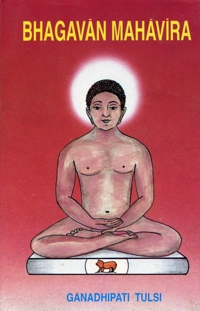 | Chapter 8 | Nirvana (Liberation) |

nce Bhagavan Mahavira reached Pava after visiting various villages. King Hastipala and his subjects assembled to pay their obeisance to him. Bhagavan Mahavira expounded to them the concept of nirvana. He was the most effective exponent of the concept of nirvana. After his discourse, he called Gautama and said, "Gautama, a Brahmana named Somasarma lives at a little distance from here. He is a seeker after truth. He will certainly be enlightened if you instruct him. Go there and enlighten him."
In obedience to the instructions of Bhagavan Mahavira, Gautama proceeded to enlighten Somasarma.
Bhagavan Mahavira had been fasting for the last two days. He had not taken even water. He had been delivering long discourses explaining the effects of karma in detail. After finishing his final discourse, he entered into silence. And he adopted the lotus posture of yoga. His body was completely motionless and relaxed. He became emancipated from his gross as well as subtle bodies and became free from the shackles of birth and death. The pure and serene light of his soul attained the perfect State.
He attained the state of nirvana in the early dawn of the fifteenth day of the dark half of the lunar month of Kartika, when hardly an hour and a half was left for the sun to rise. Sudharma and a number of other ascetics were by his side. Eighteen kings of the Gana (Republics) of the Malls and Licchavis were also present there. They lighted lamps in honor of the Light of the soul of Bhagavan Mahavira.
The news of the nirvana of Bhagavan Mahavira spread far and wide. Nandivardhana, the elder brother of Bhagavan Mahavira was overwhelmed with grief when he received this news. Although the news of the attainment of the nirvana is a matter of great ecstasy, those entangled in the snares of worldly attachment behave in their own way.
Gautama Svami had gone to enlighten Somasarma; so he was stunned when he heard the news of the nirvana of Bhagavan Mahavira. He had immense devotion for Bhagavan Mahavira. In Bhagavan Mahavira Gautama's consciousness experienced perfect protection; Bhagavan Mahavira found a dependable devotee in the latter. Gautama had much attachment to the mortal frame of Bhagavan Mahavira and was not prepared to bear separation from him. His attachment to Bhagavan Mahavira had not waned even in his physical presence with the result that he could not attain the state of kaivalya. His attachment knew no bounds on hearing the news of the nirvana of the master. Being overwhelmed he was grieved like an ordinary man. But this state lasted for a few moments only. Gautama was a great sage and was conversant with Sruta (scriptural knowledge) and was possessed of an insight into the Truth. He had a privilege of being associated with Bhagavan Mahavira for a long period of thirty years. He exerted himself by engaging his thirst for knowledge in gaining philosophical knowledge. The Bhagavati Sutra bears a living testimony to these efforts of Gautama. Such a wise man could not be lost in sorrow. He regained himself. The image of Bhagavan Mahavira symbolizing non-attachment flashed before his eyes. His attachment melted away. He himself became free from all attachments, and attained the state of Kaivalya. Now he was no more separate from Bhagavan Mahavira.
Bhagavan Mahavira attained the nirvana at the age of seventy-two. He had lived the life of a householder for thirty years, that of sadhana for twelve and a half years and that of a Kevali for another thirty years. Highly enlightened ascetics like Gautama and Sudharma were his disciples, and even though they were eighty years old, they behaved before Bhagavan Mahavira with great modesty and dedication. Bhagavan Mahavira had a large number of disciples at the time of his nirvana.
 Acharya Tulsi
Acharya Tulsi

